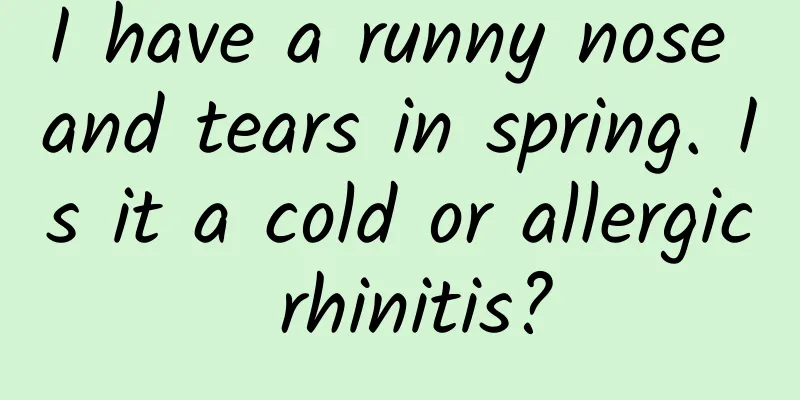I have a runny nose and tears in spring. Is it a cold or allergic rhinitis?

|
In spring, flowers bloom in abundance, bringing picturesque scenery. However, some people often experience itchy noses, sneezing, and runny noses in this beautiful season. Many people think it is a "cold", but anti-cold treatment for several weeks cannot completely relieve it. In fact, it is not a cold , but allergic rhinitis . In order to draw public attention to nasal health, China has designated the second Saturday of April every year as "National Nose Care Day". The nose is a sensory organ of the human body and a gateway to breathing. It has important functions: breathing, smelling, and air filtering. However, with the air pollution and environmental damage brought about by the accelerated industrialization and modernization of society, the incidence of nasal inflammatory diseases has increased year by year . The latest research shows that the incidence of allergic rhinitis in children can reach 15.79%. Epidemiological studies have shown that in the past few decades, the incidence of allergic rhinitis has gradually increased in countries around the world, affecting countries around the world, up to 40% of the population. 1. What is allergic rhinitis? Allergic rhinitis (hereinafter referred to as "AR"), also known as allergic rhinitis, refers to the IgE-mediated allergic inflammation of the nasal mucosa after allergens in the in vitro environment act on atopic individuals. The main clinical manifestations are sudden and recurrent nasal itching, sneezing, runny nose and nasal congestion. Allergic rhinitis is a very common disease with a global incidence of 10% to 25%, and the number of patients is increasing year by year, seriously affecting the quality of life of patients. 2. What are the symptoms of allergic rhinitis? Typical symptoms of AR include paroxysmal sneezing, watery nasal discharge, nasal itching and nasal congestion ; they may be accompanied by eye symptoms, including itchy eyes, tearing, red eyes and burning sensation, which are more common in patients with pollen allergies. When the season of allergenic pollen drifts, patients with pollen allergies will experience nasal and eye symptoms that may worsen. If the allergy is caused by indoor allergens (dust mites, cockroaches, animal dander, etc.), the symptoms will occur all year round. 3. What are the common medications used to treat allergic rhinitis? The treatment principles for allergic rhinitis should integrate environmental control, drug treatment, health education, and immunotherapy . At present, the main clinical treatments for allergic rhinitis are antihistamines (such as new oral antihistamines levocetirizine and desloratadine; nasal antihistamines azelastine hydrochloride nasal spray and levocabastine hydrochloride nasal spray), nasal glucocorticoids (such as mometasone furoate nasal spray, fluticasone propionate nasal spray, budesonide nasal spray), anti-leukotrienes (montelukast sodium, zafirlukast), mast cell membrane stabilizers (such as sodium cromoglycate), intranasal decongestants (furoxene nasal drops, xylometazoline nasal spray, oxymetazoline nasal drops), and anti-IgE monoclonal antibodies. At present, many countries use nasal glucocorticoids as the first choice for the treatment of allergic rhinitis. 4. 5 tips for treating nasal congestion A stuffy nose is usually caused by swelling of the nasal mucosa, dilation of blood vessels under the nasal mucosa leading to swelling of the nasal concha, and excessive nasal secretions. The following methods can help the nose to be ventilated quickly: Using saline to rinse the nasal cavity can relieve nasal congestion caused by acute or chronic rhinitis. Apply peppermint oil near the nostrils. Peppermint oil has a special aroma and can clear the wind and heat. Yingxiang point has the effect of opening the orifices and dispersing wind. It is located next to the midpoint of the outer edge of the nose wing and at the nasolabial groove. Pressing and rubbing it with the thumb more than a hundred times can relieve nasal congestion. Pay attention to keeping warm on a daily basis, control allergic rhinitis in time, and relieve nasal congestion caused by swelling of the nasal mucosa. Applying a hot towel to the nose can relieve nasal congestion , or using hot steam to fumigate the nasal cavity, the temperature should be tolerable. 5. Recommendations for nose protection (1) Pay attention to the cleanliness of the air in the environment to avoid dust containing allergens and germs that may damage the health of the respiratory tract. (2) Wearing a mask during seasonal changes, sensitive seasons, and in confined places with people can reduce irritation to the nasal mucosa. (3) It is recommended to wash hands, face and nose on foggy days or after going out to prevent respiratory diseases. (4) Improve nutrition, keep exercising, and enhance physical fitness and immunity. (5) Get rid of the bad habit of picking your nose with your hands to reduce the risk of infection and avoid diseases such as nosebleeds and vestibulitis. (6) The correct way to blow your nose is to press one nostril and blow it out with a little force, then alternate nostrils, or suck the mucus back and spit it out through the mouth. |
<<: Magic! Why did the dream I had actually happen a few days later?
>>: Will Jupiter's hydrogen burn up and eventually become a small sun?
Recommend
How can Tesla's electronic rearview mirror overcome the triple tests of technology, regulations and market?
Tesla has always had an ambitious plan to replace...
Hearthstone designer: Only by making the game you want to make can you succeed
The success of Hearthstone once again proves that...
To improve the conversion rate of product details page, you need to do these four things
Generally speaking, the product details page we a...
Segment your users and how to conquer them one by one?
Today, we will talk about practical techniques fo...
Phenomenal marketing cases in the first half of 2019!
2019 is already halfway over, so let’s follow the...
Will rubbing your eyes often make you blind? No kidding! Pay attention to these things
Reviewer of this article: Xu Qibin, associate chi...
How to promote and attract traffic to Douyin? What are the 6 ways to attract fans and traffic to Douyin?
There are 6 main ways to attract customers on Dou...
Renewing domain name for a long time is helpful for ranking
In a patent application filed by Google in Decemb...
Apple Watch has a new bug that restarts when you ask Siri about the weather
According to foreign media reports, Apple Watch h...
How does Meituan trick its members?
The Double 11 and Double 12 carnival is over, are...
What are the functions of the WeChat Convenience Store Mini Program? How to create a convenience store mini program?
As people's pace of life continues to accelera...
Wuhan tea drinking sn tea friends recommend sharing tea tasting health high-end club
Wuhan health tea consultation 132-7243-3196 (sync...
Is Dong Mingzhu making a mistake by failing to diversify her cross-border business?
"There's no way I'm going to buy a G...
Netflix apologizes for new film promotion, poster criticized for being too sexy!
Video streaming giant Netflix recently released a...
Who is most likely to become the fourth pole of China's Internet?
[[157689]] BAT has already occupied an absolutely...









